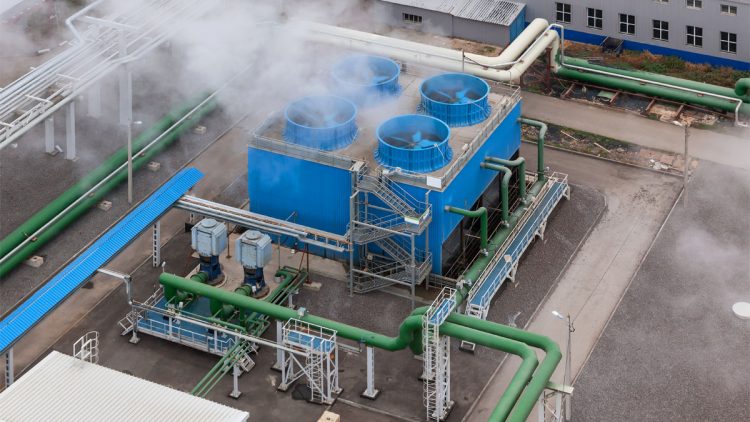Are you searching for “What Are Industrial Chillers?” If so All Kote Lining Inc. has you covered with both information about what they are and can handle any of your chiller repair needs in the Phoenix metro area. Industrial chillers are designated for use as refrigeration systems which cool process fluids. They are also used to dehumidify air in industrial or commercial facilities. Chillers will use either absorption cycles or vapor compression to cool. The water that is chilled by these machines is used for various applications including cooling industrial fabrication processes and to cool large commercial spaces.
Industrial Chiller Types
Each chiller has a rating of between 1 and 1000 tons of cooling energy. There are three main categories or types of chillers, evaporative condensed, water, and air chillers. Each of these types also has 4 different technologies for getting the job done, absorption, screw driven, reciprocating, and centrifugal chillers. Screws driven, reciprocating, and centrifugal are all mechanically driven systems, absorption chillers differ in the fact that its operations via a heat source and has no moving parts.
Industrial Chiller Components
Mechanical compressor type chillers have four basic components stages that the refrigerant must pass through. These are going through the evaporator, the compressor, condenser, and lastly the expansion valve. Evaporators operate at lower pressure and temperatures than chiller condensers.
How Industrial Chillers Work
Chillers work by passing refrigerant, typically water or air, through a series of components to change the condition of the refrigerant to expand and contract. This process results in heat transfer and cooling for the purpose of cooling industrial fabrication processes, or air for HVAC systems in large commercial buildings.
Condenser Stage
Condensers are the start and end of the cycle for chillers. As the refrigerant passes through the expansion valve it returns to the condenser as a superheated gas. It must be brought back down to the level where the gas is at the saturation temperature. This is the point where the condenser can start condensing the refrigerant back into a liquid. This is done by continuing to transfer heat from the refrigerant to the air. The system will continue until the refrigerant is completely condensed back down. In theory, this process happens at the outlet of the condenser. In application, a degree of subcooling is expected at the condenser outlet. To prevent liquid flashing subcooled liquid helps avoid pressure losses in the components and tubing.
Lowering Refrigerant Temperature
When the liquid leaves the condenser it is under high pressure and is at a high temperature. Before it can be used as a refrigerant again it must be cooled. This is accomplished by reducing the pressure the refrigerant is under. The relation between the pressure and temperature is a law of physics and you can count on the refrigerant cooling if the pressure is lowered.
To reduce the temperature pressure is reduced by first having a system of pressure restriction. This is accomplished with a thermostatic expansion valve. This is useful as the pressure varies based on the load on the system. A thermostatic expansion valve can adjust for load, pressure, and temperature variations as the system have lower and greater loads applied. This valve will act to lower the pressure, and by affecting the temperature of the refrigerant. The valve is limited to only produce a predetermined pressure change that fits with system design and load conditions.
The cycle has dropped in the thermostatic expansion valve. When there is a mixture of both liquid and vapor states of refrigerant Subcooling or superheating is not possible. For this reason any place in the system where both states of refrigerant exist, the pressure and saturation temperature will match.
A portion of the liquid refrigerant must boil to help exchange sufficient heat to lower the temperature of the system. This is another process that results in heat transfer and lower liquid temperature. When there is a large difference in temperature between the liquid and vapor states more refrigerant will need to be boiled off to achieve saturation temperature. This process improves greater refrigerant quality.
The last stage of the refrigerants journey is a mix of vapor and liquid. It passes through the evaporator tubing and warm air is blown over the evaporator. This is where the heat is transferred to the boiling refrigerant. The latent heat gain experience by the refrigerant causes to temperature increase, yet it does experience a change of state. In the best case scenario, the last molecule of liquid refrigerant boils off by the evaporator outlet. This is then passed through the to the compressor inlet. This is how the refrigerant is passed back to the start at the condenser.
What Is An Air Cooled Chiller?
Air-cooled chillers are a type of refrigeration system used in industrial and commercial facilities to dehumidify air and/or cool fluids. Learn more about air cooled chillers.
Phoenix Chiller Maintenance & Repair
If you have a Chiller in the Phoenix valley it needs regular maintenance to work without using too much energy. The tubes need regular cleaning and coatings can be applied to help reduce scaling and build up that rob you of energy. If you need chiller repair or industrial chiller coatings, we can help you get your system back up and running. We also work on cooling towers that are commonly associated with chiller systems. We offer a complete maintenance and repair service for all industrial and commercial chillers in the Phoenix valley. Call us today for service at 480-966-4446

